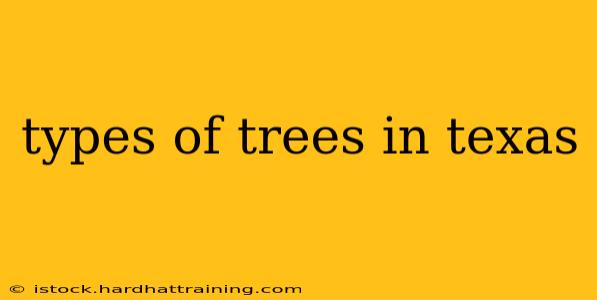Texas boasts a remarkably diverse landscape, and this diversity is reflected in its rich variety of trees. From the towering pines of East Texas to the drought-resistant oaks of the Hill Country, the Lone Star State is home to a fascinating array of species. This guide explores some of the most common and notable tree types found across the different regions of Texas. Understanding these trees not only enhances our appreciation of the state's natural beauty but also helps in responsible land management and conservation efforts.
Common Texas Tree Families & Notable Species
Texas' varied climates and soils support a wide range of tree families, each with its own distinct characteristics. Let's delve into some prominent examples:
1. Oak Trees (Quercus)
Perhaps the most iconic Texas trees, oaks dominate many landscapes. Their resilience to drought and diverse forms make them a staple.
- Live Oak (Quercus virginiana): A symbol of Texas, the live oak is known for its sprawling, majestic branches and evergreen foliage. It thrives in coastal plains and thrives in the humid conditions of East Texas, often reaching monumental sizes.
- Post Oak (Quercus stellata): Extremely drought-tolerant, the post oak is a common sight in the central and western parts of the state. Its distinctive leaves, shaped like a cross, are easily recognizable.
- Bur Oak (Quercus macrocarpa): One of the largest oak species in North America, the bur oak can be found across much of Texas, known for its large acorns and tolerance of various soil types.
- Red Oak (Quercus rubra): While not as prevalent as other Texas oaks, red oak trees bring vibrant autumn color to some parts of the state, primarily in East Texas.
2. Pine Trees (Pinus)
East Texas and the Piney Woods region are characterized by their dense pine forests, providing vital habitats and resources.
- Loblolly Pine (Pinus taeda): The most common pine in East Texas, loblolly pines are fast-growing and commercially significant for timber production.
- Shortleaf Pine (Pinus echinata): Another important timber species, the shortleaf pine is found in drier uplands throughout much of the state.
- Longleaf Pine (Pinus palustris): Once dominant across the southeastern United States, longleaf pines are now less common but are crucial for biodiversity in their remaining habitats. Restoration efforts are underway to increase their numbers.
3. Pecan Trees (Carya illinoinensis)
Texas is a major pecan-producing state, and these majestic trees are a valuable part of the agricultural landscape. They require ample water and fertile soil to flourish, often found along rivers and streams. Their tasty nuts are a prized harvest.
4. Other Notable Texas Trees
Beyond oaks, pines, and pecans, many other tree species add to the state's botanical richness.
- Mesquite (Prosopis): Highly drought-resistant, mesquite trees are prevalent in the drier regions of Texas, often forming dense thickets.
- Juniper (Juniperus): Several juniper species, including Ashe juniper (commonly called cedar), are widespread across the state, particularly in the Hill Country.
- Hackberry (Celtis): Hackberries are adaptable trees found throughout Texas, often growing along waterways or in disturbed areas.
- Sweetgum (Liquidambar styraciflua): Known for its star-shaped leaves and fragrant gum, the sweetgum adds a touch of beauty to East Texas forests.
Factors Influencing Tree Distribution
The distribution of tree species in Texas is heavily influenced by several factors:
- Climate: Temperature, rainfall, and frost frequency play crucial roles in determining which species can thrive in a particular region.
- Soil type: Different tree species have different soil requirements regarding drainage, nutrient content, and pH.
- Elevation: Elevation significantly impacts temperature, precipitation, and soil conditions, resulting in diverse tree communities at different altitudes.
Conclusion
Texas' diverse tree population is a testament to its varied geography and climate. From the majestic live oaks to the towering pines, each tree plays a vital role in the state's ecosystems. Appreciating the unique characteristics of these trees and understanding the factors influencing their distribution is crucial for promoting responsible land management and ensuring the preservation of Texas' natural heritage. Further research into specific regions and their unique flora will offer a deeper appreciation for the incredible botanical diversity within the Lone Star State.
